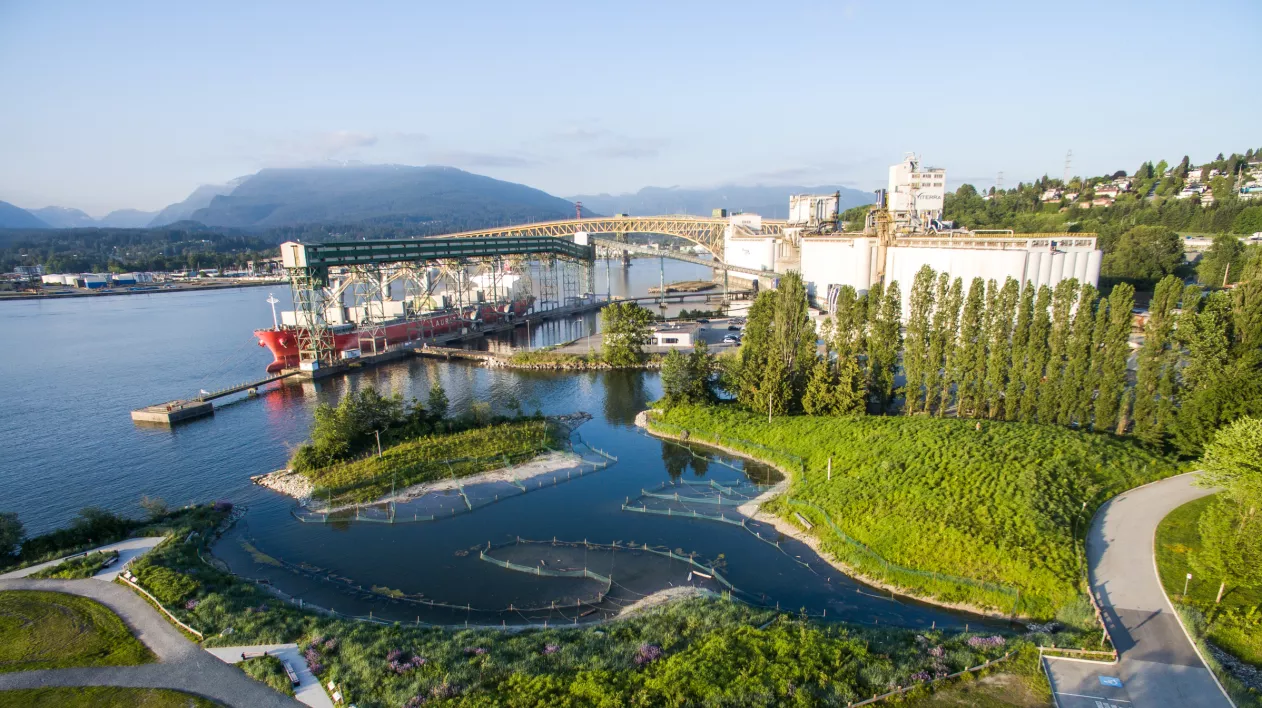Maintaining healthy ecosystems at the Port of Vancouver
The Port of Vancouver operates in a region with the greatest biodiversity of any province in Canada. We know port operations and infrastructure development can cause habitat loss and degradation, which in turn can affect biodiversity and habitat productivity. This is why we run a suite of programs and initiatives aimed at reducing potential impacts of port-related activity.
Enhancing Cetacean Habitat and Observation (ECHO) Program

In 2014, the Vancouver Fraser Port Authority launched the Enhancing Cetacean Habitat and Observation (ECHO) Program to help us better understand and reduce the impacts of shipping on whales throughout the southern coast of British Columbia. The ECHO Program is one of the ways we are working to help reduce the impacts of port-related activity on endangered Southern Resident Killer Whales.
This world-leading, first-of-its-kind program develops and supports a wide range of collaborative projects, on-water actions and educational initiatives, including:
- Underwater noise reduction initiatives such as voluntary ship slowdowns through critical habitats and moving tugboats away from key feeding areas for at-risk whales
- Monitoring, reporting, and sharing peer-reviewed papers on the impacts and mitigations for marine shipping on at-risk whales
- Tutorials, guides, and reporting apps specifically for mariners
ECHO Program projects and initiatives
The ECHO Program collaborates with over a hundred Canadian and U.S. partners and advisors from across government agencies, the marine transportation industry, Indigenous communities, and environmental groups. Bringing groups together from a diverse range of industries, perspectives, and areas of expertise helps ensure that the ECHO Program’s work is informed by cultural, economic and environmental best practices.
The long-term goal of the ECHO Program is to develop and implement initiatives that result in a quantifiable reduction in threats to whales as a result of shipping activities. The ECHO Program’s work does not focus on any individual organization, nor any specific external project, program or initiative. Instead, the ECHO Program seeks to bring all relevant interests together to combine efforts and leverage shared resources in support of at-risk whales in the region.
For questions or more information about the ECHO Program, please contact ECHO@portvancouver.com.
Subscribe to the ECHO Program newsletter for updates on projects and initiatives.
Project and environmental review process

Our project and environmental review (PER) process allows us to review and consider potential effects from proposed project development on federal lands and waters, and neighbouring communities before determining if a project should proceed. PER is one of the tools we use to fulfill our environmental stewardship obligations under the Canada Marine Act and the Impact Assessment Act. It is also one of the ways that we can reduce impacts of port-related activity on at-risk species, which are legally protected on federal lands under the Species at Risk Act.
This PER process helps us:
- Ensure port lands and waters are used responsibly
- Protect fish, wildlife, habitats, at-risk species
- Prevent the spread of invasive species
- Manage and mitigate underwater noise from project construction
Mitigation activities
Through this process, we work with port tenants to develop mitigation activities for proposed projects. Examples of these activities include:
- Shifting development around trees to the winter months to reduce impacts to forest-dwelling endangered species
- Checking for birds’ nests or bat roosts before conducting maintenance or demolishing structures
- Adjusting timing of activities in the Fraser River to avoid harm to juvenile salmon
- Monitoring the project area for environmental contaminants
For questions or more information about how the PER process helps protect local ecosystems, please contact PER@portvancouver.com.

Habitat Enhancement Program
Our Habitat Enhancement Program (HEP) focuses on creating and enhancing habitat to benefit fish and wildlife throughout the Lower Mainland region. The program is a proactive measure intended to provide a balance between a healthy environment and future development that may be required by the Vancouver Fraser Port Authority, its tenants or terminals.
Through a 15-year agreement with Fisheries and Oceans Canada, HEP administers a habitat bank that allows us to directly offset effects of port development on fish and fish habitat.
In addition to this agreement, we consult with First Nations, all levels of government, neighbouring communities, and other regulators on these projects. This allows us to make sure the interests of all parties are considered, for the benefit of everyone. We have also collaborated with environmental organizations, such as Ducks Unlimited and the Pacific Salmon Foundation, to leverage their expertise when enhancing habitats that benefit fish and other wildlife.
Over the last 30 years, we—with our partners—have completed habitat enhancement sites across the Lower Mainland region, including:
- New Brighton Park Shoreline Habitat Restoration Project
- Maplewood Marine Restoration
- Salt Marsh Restoration Projects
- Glenrose Tidal Marsh Project
- Timberland Basin Habitat Project
- Gladstone Park Tidal Marsh Project
- Riverfront Park Tidal Marsh Project
For questions or more information about our habitat enhancement work, please contact habitat.enhancement@portvancouver.com.

Contaminated sites management
As shared stewards of the Port of Vancouver, we work to improve and maintain port lands and waters to meet federal and/or provincial environmental standards. Our oversight includes managing and remediating contaminated sites to make sure they are ready for marine terminals and other facilities. We require port tenants to comply with lease requirements, including those that protect the port lands and waters from contamination.
Port tenants must complete an environmental site assessment at the start or end of their tenancy. An environmental site assessment provides:
- An overview of the condition of a site
- Any areas of concern that may need to be cleaned up
Our environmental site assessment guidance document provides details on our environmental standards and expectations for any site assessment submitted to the port authority.
If you have questions or would like more information about how we maintain healthy ecosystems at the Port of Vancouver, please contact environmentalprograms@portvancouver.com.
Read our sustainability report to learn more about how we’re advancing sustainability at the port authority and across the maritime sector.
